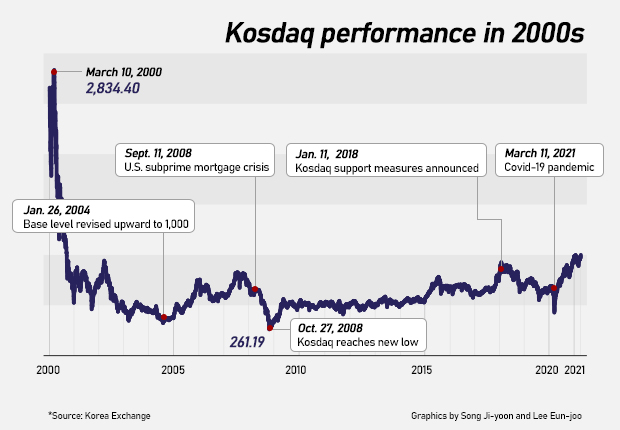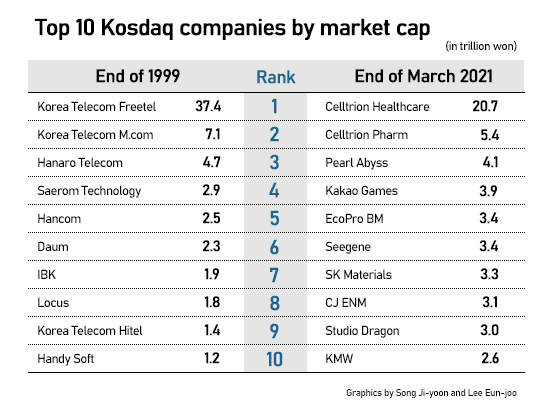Kosdaq revisits 1,000 threshold for the first time in nearly 21 years
이 글자크기로 변경됩니다.
(예시) 가장 빠른 뉴스가 있고 다양한 정보, 쌍방향 소통이 숨쉬는 다음뉴스를 만나보세요. 다음뉴스는 국내외 주요이슈와 실시간 속보, 문화생활 및 다양한 분야의 뉴스를 입체적으로 전달하고 있습니다.
![[Photo by Han Joo-hyung]](https://img1.daumcdn.net/thumb/R658x0.q70/?fname=https://t1.daumcdn.net/news/202104/13/mk/20210413110002415zkfv.jpg)
Kosdaq finished Monday 1.1 percent higher at 1,000.65 points, its first touchdown above the 1,000 threshold since 1,020.7 closing on September 14, 2000. Market cap also reached a new record of 11.1 trillion won ($365.5 billion) on Monday.
Kosdaq was 0.8 percent higher at 1,008.43 by midday Tuesday.
The latest traction in the junior index mainly came from offshore investors.
On Monday, foreigners net bought 39.5 billion won in Kosdaq shares and institutional investors 1.8 billion won. Retail investors net sold 19.9 billion won.
Bio and battery stocks led the gains.

Shares of Seegene, Korea’s Covid-19 test kit maker rose 4.31 percent after reports that it is prepping to move to the bigger Kospi market.
Kosdaq has been galloping after decades of stagnation. It has more than doubled from last low of 428.35 marked on March 19 last year. It outperformed Nasdaq gains of 88 percent from last year’s low and Japan Nikkei 225’s 66 percent and China’s Shanghai Composite’s 31 percent.
Kospi during the same period surged 115 percent.
Park Byeong-yong, head of Kosdaq sales system at Korea Exchange, said that the Kosdaq index was able to leapfrog on the back of innovative companies with growth potential and promising future technologies.

Individuals purchased 5.3 trillion won worth of Kosdaq shares as of Monday, which is in contrast to how institutional investors net sold nearly 3 trillion won and foreigners 785.9 billion won.
Diversity in up-and-coming stocks added to the market appeal.
When the secondary market was launched in 1996, the index was mainly led by IT companies. In recent years, it was joined by bio, battery and fifth-generation mobile names players.
[ⓒ Maeil Business Newspaper & mk.co.kr, All rights reserved]
Copyright © 매일경제 & mk.co.kr. 무단 전재, 재배포 및 AI학습 이용 금지
- Seoul “strongly regrets” Tokyo decision to release radioactive water - Pulse by Maeil Business News Korea
- Netflix’s income in Korea quadruples in the year of pandemic - Pulse by Maeil Business News Korea
- Hanwha Solutions to offer $153 mn in green dim sum bond in May - Pulse by Maeil Business News Korea
- S. Korea’s money supply rises by record pace in Feb for the second month - Pulse by Maeil Business News Korea
- Additional US sanction on chip material exports to China may upset Samsung, SK hynix upgrade - Pulse by Maeil Business News Kore
- 강경준, 상간남 피소…사랑꾼 이미지 타격 [MK픽] - 스타투데이
- 5년 전 잘못된 만남? ‘신세계’는 없었다 [스페셜리포트]
- 檢, ‘14살 트로트 가수’ 오유진 스토킹한 60대男 집유 선고에 항소 - MK스포츠
- 이찬원, 이태원 참사에 "노래 못해요" 했다가 봉변 당했다 - 스타투데이
- 양희은·양희경 자매, 오늘(4일) 모친상 - 스타투데이